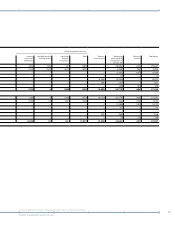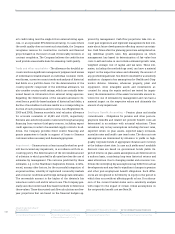Siemens 2009 Annual Report Download - page 219
Download and view the complete annual report
Please find page 219 of the 2009 Siemens annual report below. You can navigate through the pages in the report by either clicking on the pages listed below, or by using the keyword search tool below to find specific information within the annual report.
Managing Board statements, Independent auditors’ report, Additional information
Notes to Consolidated Financial Statements
(in millions of €, except where otherwise
stated and per share amounts)
not recognize further losses, unless it incurs obligations or
makes payments on behalf of the associate. Intercompany re-
sults arising from transactions between Siemens and its asso-
ciated companies are eliminated to the extent of Siemens’ in-
terest in the associated company.
Foreign currency translation – The assets and liabilities of
foreign subsidiaries, where the functional currency is other
than the euro, are translated using period-end exchange rates,
while the statements of income are translated using average
exchange rates during the period. Differences arising from
such translations are recognized within equity.
The exchange rates of the significant currencies of non-euro
countries used in the preparation of the Consolidated Finan-
cial Statements were as follows:
Revenue recognition – Revenue is recognized for product
sales when persuasive evidence of an arrangement exists, de-
livery has occurred or services have been rendered, the risks
and rewards of ownership have been transferred to the cus-
tomer, the amount of revenue can be measured reliably, and
collection of the related receivable is reasonably assured. If
product sales are subject to customer acceptance, revenue is
not recognized until customer acceptance occurs. Revenues
from construction-type projects are generally recognized un-
der the percentage-of-completion method, based on the per-
centage of costs to date compared to the total estimated con-
tract costs, contractual milestones or performance. Revenues
from service transactions are recognized as services are per-
formed. For long-term service contracts, revenues are recog-
nized on a straight-line basis over the term of the contract or, if
the performance pattern is other than straight-line, as the ser-
vices are provided. Revenue from software arrangements is
recognized at the time persuasive evidence of an arrangement
exists, delivery has occurred, the amount of revenue can be
measured reliably and collectability is probable. Revenue from
maintenance, unspecified upgrades or enhancements and
technical support is allocated using the residual value method
and is recognized over the period such items are delivered. If
an arrangement to deliver software requires significant pro-
duction, modification, or customization of software, the entire
arrangement is accounted for under the percentage-of-com-
pletion method. Operating lease income for equipment rentals
is recognized on a straight-line basis over the lease term. Re-
ceivables from finance leases, in which Siemens as lessor
transfers substantially all the risks and rewards incidental to
ownership to the customer are recognized at an amount equal
to the net investment in the lease. Finance income is subse-
quently recognized based on a pattern reflecting a constant
periodic rate of return on the net investment using the effec
tive
interest method. A selling profit component on manufacturing
leases is recognized based on the policies for outright sales.
Dividends are recognized when the right to receive payment is
established. Royalties are recognized on an accrual basis in ac-
cordance with the substance of the relevant agreement.
Sales of goods and services sometimes involve the provision of
multiple elements. In these cases, the Company determines
whether the contract or arrangement contains more than one
unit of accounting. An arrangement is separated if (1) the de-
livered element(s) has (have) value to the customer on a
stand-alone basis, (2) there is reliable evidence of the fair value
of the undelivered element(s) and (3), if the arrangement in-
cludes a general right of return relative to the delivered
element(s), delivery or performance of the undelivered
element(s) is (are) considered probable and substantially in
the control of the Company. If all three criteria are fulfilled, the
appropriate revenue recognition convention is then applied to
each separate unit of accounting. Generally, the total arrange-
ment consideration is allocated to the separate units of ac-
counting based on their relative fair values. In cases where
there is reliable fair value evidence of the undelivered ele-
ments but not for one or more of the delivered elements, the
residual method is used, i.e. the amount allocated to delivered
elements equals the total arrangement consideration less the
aggregate fair value of the undelivered elements. Reliable fair
Year-end exchange
rate € quoted into
currencies
specified below
Annual average rate
€ quoted into
currencies specified
below
September , Fiscal year
Currency ISO Code
U.S. Dollar USD 1.464 1.430 1.361 1.507
British Pound GBP 0.909 0.790 0.875 0.763
B27T001_E
























